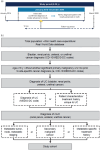Real-world epidemiology and treatment patterns of patients with locally advanced or metastatic urothelial carcinoma: Retrospective analysis of Diagnosis Procedure Combination claims data in Japan
- PMID: 38468564
- PMCID: PMC11524106
- DOI: 10.1111/iju.15450
Real-world epidemiology and treatment patterns of patients with locally advanced or metastatic urothelial carcinoma: Retrospective analysis of Diagnosis Procedure Combination claims data in Japan
Abstract
Objectives: Evaluate real-world epidemiologic trends and treatment patterns in newly diagnosed patients with locally advanced or metastatic urothelial carcinoma (la/mUC) in Japan.
Methods: This retrospective analysis included adults with newly diagnosed la/mUC in Japan (January 2015-December 2019) from a nationwide-linked electronic medical record Diagnostic Procedure Combination claims dataset. Outcomes included epidemiologic trends (incidence and prevalence), baseline demographics, clinical characteristics, and treatment patterns in newly diagnosed patients with la/mUC before (2015-2017) and after (2018-2019) approval of pembrolizumab in Japan.
Results: Of 975 patients included, 76.4% were men; 71.6% were aged 70 years or older. Most cases (70.5%) were of the bladder. Between 2015 and 2019, the annual age-adjusted incidence increased from 6.8 to 12.4 per 100 000; the annual age-adjusted period prevalence increased from 13.0 to 25.2 per 100 000; and 307 (31.5%) and 668 (68.5%) patients were diagnosed from 2015 to 2017 and 2018 to 2019, respectively. Overall, 731 (75%) patients received systemic anticancer therapy; all received 1 line and 50.2% received 2 lines of therapy; 78.3% of patients received gemcitabine plus platinum-based therapy and 2.2% received pembrolizumab as first-line treatment. First-line treatment rates increased from 69.4% to 77.5% after pembrolizumab approval. Of 367 patients who received second-line treatment, 22.3% received gemcitabine plus platinum-based therapy; 14.7% received pembrolizumab.
Conclusions: In the Japanese regions considered, incidence and prevalence of newly diagnosed la/mUC increased over time and first-line treatment with pembrolizumab increased after approval.
Keywords: Japan; epidemiology; locally advanced/ metastatic urothelial carcinoma; real‐world; retrospective analysis; treatment patterns.
© 2024 The Authors. International Journal of Urology published by John Wiley & Sons Australia, Ltd on behalf of The Japanese Urological Association.
Conflict of interest statement
Keiko Asakawa is an employee of Astellas Pharma, Inc., and declares no other conflict of interest. Miina Waratani is an employee of Astellas Pharma, Inc., and declares no other conflict of interest. Olivia Massey reports that employer, Adelphi Real World, received funding from Astellas Pharma, Inc., to design and conduct the study. Tim Holbrook has nothing to report. Makoto Kondo has nothing to report. Atsushi Saito is an employee of Astellas Pharma, Inc., and declares no other conflict of interest. Hiroyuki Nishiyama reports grants from Astellas Pharma, Inc., Ono Pharmaceutical, Takeda Pharmaceutical, and Bayer; and reports payment or honoraria for speakers bureaus from MSD, Chugai Pharmaceutical, and Olympus.
Figures




Similar articles
-
Real-world treatment patterns and outcomes of patients with unresectable or metastatic urothelial carcinoma receiving systemic therapy in Japan.Urol Oncol. 2025 May;43(5):329.e1-329.e8. doi: 10.1016/j.urolonc.2024.09.020. Epub 2024 Oct 15. Urol Oncol. 2025. PMID: 39414520
-
Epidemiology, resource use, and treatment patterns of locally advanced or metastatic urothelial carcinoma in France.Future Oncol. 2025 Mar;21(6):665-679. doi: 10.1080/14796694.2025.2459058. Epub 2025 Feb 20. Future Oncol. 2025. PMID: 39973175 Free PMC article.
-
Enfortumab vedotin prolongs overall survival in metastatic urothelial carcinoma following pembrolizumab therapy in real-world data.Int J Urol. 2024 Jun;31(6):678-684. doi: 10.1111/iju.15437. Epub 2024 Feb 25. Int J Urol. 2024. PMID: 38402449
-
Epidemiology and treatment patterns for locally advanced or metastatic urothelial carcinoma: a systematic literature review and gap analysis.J Manag Care Spec Pharm. 2021 Feb;27(2):240-255. doi: 10.18553/jmcp.2020.20285. Epub 2020 Dec 23. J Manag Care Spec Pharm. 2021. PMID: 33355035 Free PMC article.
-
Real-world treatment patterns and clinical outcomes in patients with locally advanced or metastatic urothelial carcinoma in Germany: retrospective CONVINCE study.J Cancer Res Clin Oncol. 2025 Mar 5;151(3):100. doi: 10.1007/s00432-025-06131-y. J Cancer Res Clin Oncol. 2025. PMID: 40042678 Free PMC article. Review.
Cited by
-
Efficacy of modified enfortumab vedotin ineligible criteria (mEVITA) in advanced urothelial carcinoma.Sci Rep. 2025 Jul 18;15(1):26127. doi: 10.1038/s41598-025-09806-1. Sci Rep. 2025. PMID: 40681533 Free PMC article.
References
-
- Ferlay J, Ervik M, Lam F, Laversanne M, Colombet M, Mery L, et al. Global cancer observatory: cancer today. 2020. Available from: https://gco.iarc.fr/today
-
- Alifrangis C, McGovern U, Freeman A, Powles T, Linch M. Molecular and histopathology directed therapy for advanced bladder cancer. Nat Rev Urol. 2019;16:465–483. - PubMed
-
- Miyazaki J, Nishiyama H. Epidemiology of urothelial carcinoma. Int J Urol. 2017;24:730–734. - PubMed
-
- Mori K, Abufaraj M, Mostafaei H, Quhal F, Karakiewicz PI, Briganti A, et al. A systematic review and meta‐analysis of variant histology in urothelial carcinoma of the bladder treated with radical cystectomy. J Urol. 2020;204:1129–1140. - PubMed
MeSH terms
Substances
Grants and funding
LinkOut - more resources
Full Text Sources

